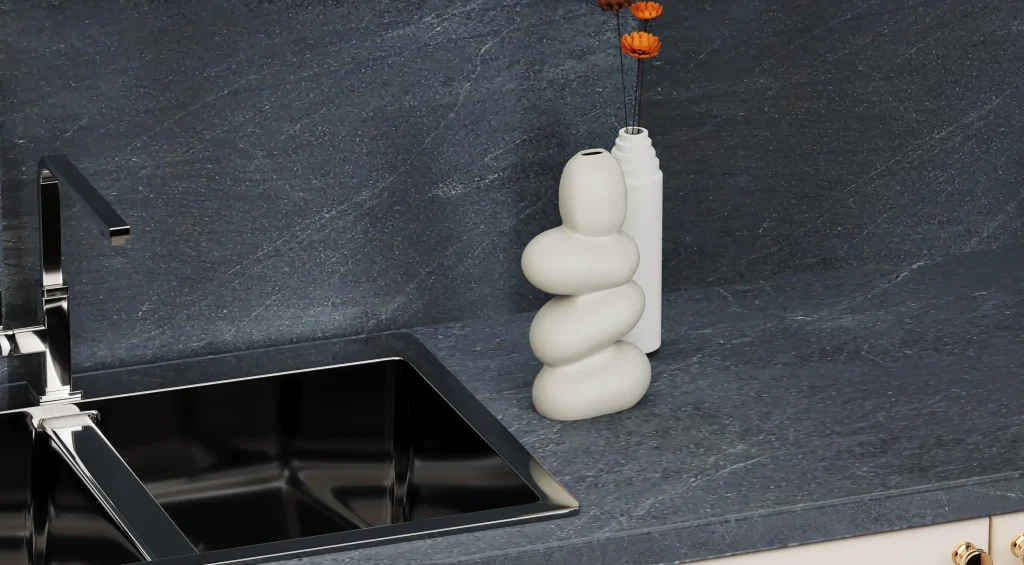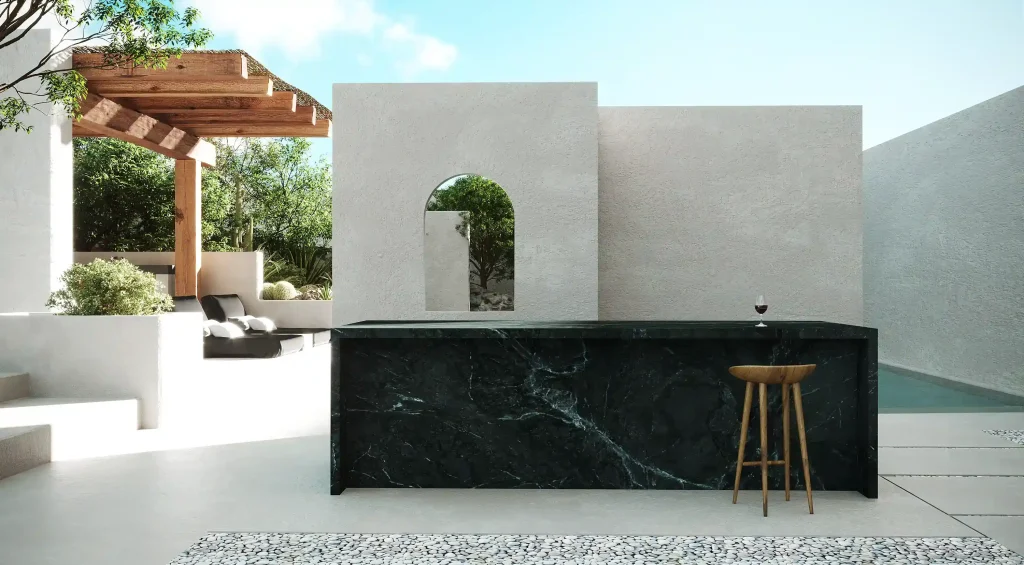Unique and versatile – soapstone is an unsung hero in the stone industry. While it is not as talked about as marble or granite, the multifaceted stone has been a part of civilisation from prehistoric times. Soapstone countertops are now becoming more popular than they were before, thanks to their incredible features. In this blog, we are going to show you why soapstone can be a valuable asset to your home.
The Formation of Soapstone
Soapstone, geologically known as Steatite, is a metamorphic rock similar to marble. The stone is formed when magnesium and iron-rich rocks, such as peridotite or serpentinite, are subjected to extreme heat and pressure over many decades. During the prolonged period of metamorphism, some minerals in these rocks recrystallize and transform into talc – the primary mineral in soapstone.
Its deposits can be traced across the world including Brazil, India, China, United States, Canada, Finland, and Italy.
How Did Soapstone Get Its Name?
The name “soapstone” was probably coined by early European settlers who used the stone for various applications and observed its unique soap like smooth texture due to the presence of talc, which is a very soft mineral and is the same mineral used in talcum powder. Just like soap, the surface feels slippery to the touch when it’s wet, leading to its unique name.
Artistic Soapstone and Architectural Soapstone
Soapstone is a versatile material in terms of both characteristics and applications, on the basis of which it is categorised into two different types – Artistic Soapstone, and Architectural Soapstone. The former variant of soapstone is a popular choice for sculpting since it has a much softer structure than the latter one. As the name suggests, architectural soapstone is used for interior design and architectural applications.
What Makes Soapstone a Game-changer Material for Countertops?
Soapstone is probably one of the most searched countertop materials on Google Trends nowadays, let us find out how soapstone earned its popularity.

Soapstone Countertops Pros
The Matte Beauty
Soapstone is cherished for its waxy-smooth, matte appearance, which can add a modern and minimalist touch to your interiors. The stone is commonly available in a grey palette, ranging from light grey to charcoal black hues, with certain variations having subtle to prominent white calcite veining that further elevates the look of the stone.
Interestingly, soapstone’s magnificent deep tones come from its dark mineral components such as olivine, pyroxene, garnet, and chromite. Despite having a limited color range, soapstone exudes a certain kind of charm that can not be compared with any other natural stone. Grey or black soapstone countertops have been on trend for the past few years and they look absolutely gorgeous when paired with white or cream-colored decorative elements.
Beyond the Usual Greys
You can also find soapstones with deep green or blue undertones that look phenomenal. The rich hues of green soapstone, often attributed to minerals like chlorite and amphibole, lend a captivating aura to the stone, enhanced by delicate veining patterns.
Are you also searching for white soapstone countertops?
White soapstone countertops are a myth. Customers are often misled by some vendors that market white marble as soapstone. However, soapstone can be white when it is purely composed of talc, which is unsuitable for architectural applications.
Soapstone and Durability
Unique Strength: While soapstone is not famed for its hardness as granite or quartzite, it is a very durable material for countertops. You may have heard that soapstone is soft because of its talc component, but its softness provides the surface with a kind of elasticity that your soapstone countertop is more likely to dent than chip from heavy impact, making it resistant to everyday wear and tear. Nevertheless, you can fix small dents by sanding or heat treatment.
No Staining or Etching: Are you constantly worried about staining your countertops while cooking? Well, soapstone outperforms marble with its exceptional resistance to stains, thanks to its outstanding dense structure. Being a non-porous material, soapstone countertops do not absorb liquids, making them perfect for those who wish to enjoy cooking without worrying about stains. Furthermore, soapstone is chemically stable, which means it is less likely to react or etch in contact with acidic substances like lemon juice, vinegar, or wine.
Exceptional Heat Resistance: People in ancient times discovered the excellent thermal properties of soapstone, and since then it has been used for various applications ranging from bed warmers to cookwares. Soapstone is ideal for kitchen countertops because it absorbs, retains, and evenly distributes heat without compromising its structural integrity.
Easy to Maintain and Repair
Unlike marble or granite, fixing minor dents and nicks on your soapstone surface is both easy and cost-effective with simple sanding and oiling from time to time. The stone develops a natural patina as it ages, which can make the stone look uneven. However, applying mineral oil once or twice might help the surface age more uniformly and bring out its deep tones.
Things to Consider When Using Soapstone Surfaces
Soapstone Countertops Cons
Scratch Prone: One of the biggest disadvantages of soapstone is that it is easily scratched by even moderately sharp objects such as keys, therefore you should avoid cutting or chopping directly on your soapstone countertop. We always recommend that you use cutting boards to protect the surface. On a positive note, you can repair minor scratches yourself by sanding the surface to a smooth finish with fine-grit sandpaper.
Requires Frequent Oiling: Soapstone surfaces, like everything else in our home, require some maintenance to retain their natural appearance. Oiling your countertop with mineral oil on a regular basis and buffing the surface can help it retain its organic appearance for a lifetime.
Limited Color Range: Unlike other countertop materials, such as quartzite or granite, soapstone has a limited color palette. However, if you want a striking statement countertop for your kitchen, feel free to explore the vibrant hues of quartzite in our inventory.
Is Soapstone Costly?
The cost of soapstone varies depending on several factors, such as availability, quality, and installation complexities. Considering these three factors, we can say that soapstone stands in the mid to high price range compared to other countertop materials. However, its rich aesthetic and unique durability make soapstone countertops worth the investment.
Soapstone is not a material for everyone, the stone becomes more personal for its users over the years of caring for it. If you are looking to renovate your kitchen with the timeless appeal of soapstone countertops, we welcome you to check our selection of the Best quality soapstone in Pennsylvania and New York at https://ultrastones.com.


